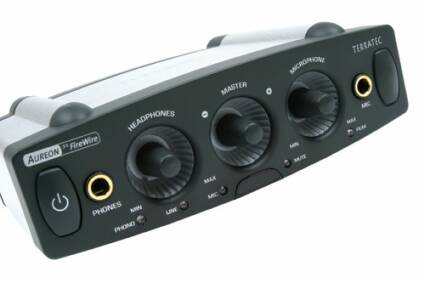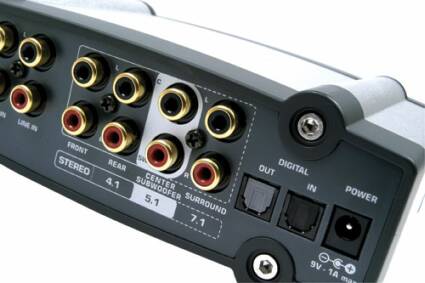Terratec's Aureon 7.1 FireWire Attempts Plug-and-Play with Pro Sound Card Performance
Inputs And Outputs
For its Aureon FireWire, Terratec has made a choice that you may find either fortunate or unfortunate, depending on your point of view. The choice is that all the sockets for attachments are of the type found in home audio equipment (Hi-Fi systems and the like) and not those found on computers. If you want to connect up to home audio equipment you'll find this handy, but if you use computer equipment or a laptop, you are going to need additional adaptors and cables. For instance, the headphone output and the mike input on the front use 1/4" jacks, and the analog audio inputs and outputs at the back, are for cinch speakers. Although adaptors are supplied to convert 1/4" jacks to 3.5 mm jacks, you will generally need to consider more accessories if you want to plug your speaker system into the FireWire box.
As far as analog input goes, the FireWire box offers three choices: mic, line and phono. Unfortunately, these inputs cannot be mixed or edited; you have to choose the one you want to use, and your selection is indicated by an LED diode on the front. The mic input on the front has a potentiometer for controlling gain and a peak indicator, showing saturation at the preamp stage. It can thus be of genuine use, unlike that on a basic sound card. On the other hand, it has no phantom power, so you will need to choose your mike carefully as a result. The line input, at the back, is for two cinch speakers. The input is paired with a phono input that also requires cinch speakers, and that can be linked directly to a turntable for vinyl disks equipped with a cell with a mobile magnet. This means there is preamplification with RIAA correction. For attaching the turntable, including a ground, Terratec provides a sort of cinch/cinch adaptor with an earthed plug. Frankly, we would very much have preferred an earthed socket on the card, as this solution looks rather clunky and makeshift.
Where digital is concerned, the situation is very simple because there are only two TOSLINK connectors, providing a single optical digital input and output. Obviously, it's unfortunate that no coaxial links were provided, as not all the equipment you might want to attach is fitted with optical connectors. True, optical links have the advantage of providing perfect galvanic insulation, which can prevent a lot of the problems that arise when you mix equipment of different origins (such as computers, home audio/video, etc).
Get Tom's Hardware's best news and in-depth reviews, straight to your inbox.


